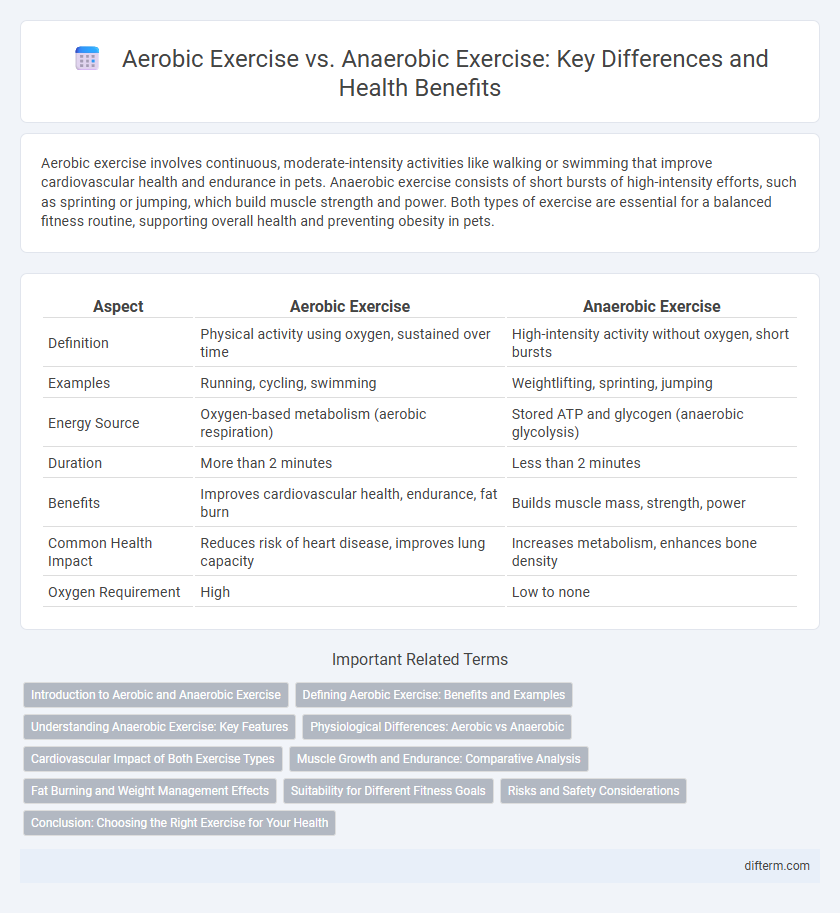Aerobic exercise involves continuous, moderate-intensity activities like walking or swimming that improve cardiovascular health and endurance in pets. Anaerobic exercise consists of short bursts of high-intensity efforts, such as sprinting or jumping, which build muscle strength and power. Both types of exercise are essential for a balanced fitness routine, supporting overall health and preventing obesity in pets.
Table of Comparison
| Aspect | Aerobic Exercise | Anaerobic Exercise |
|---|---|---|
| Definition | Physical activity using oxygen, sustained over time | High-intensity activity without oxygen, short bursts |
| Examples | Running, cycling, swimming | Weightlifting, sprinting, jumping |
| Energy Source | Oxygen-based metabolism (aerobic respiration) | Stored ATP and glycogen (anaerobic glycolysis) |
| Duration | More than 2 minutes | Less than 2 minutes |
| Benefits | Improves cardiovascular health, endurance, fat burn | Builds muscle mass, strength, power |
| Common Health Impact | Reduces risk of heart disease, improves lung capacity | Increases metabolism, enhances bone density |
| Oxygen Requirement | High | Low to none |
Introduction to Aerobic and Anaerobic Exercise
Aerobic exercise involves sustained physical activity that increases heart rate and oxygen consumption, such as running, swimming, or cycling, promoting cardiovascular endurance and fat metabolism. Anaerobic exercise consists of short bursts of intense activity like weightlifting or sprinting, relying on energy sources stored in muscles without using oxygen, leading to muscle strength and power development. Both types of exercise play crucial roles in overall fitness by targeting different energy systems and physiological adaptations.
Defining Aerobic Exercise: Benefits and Examples
Aerobic exercise involves continuous, rhythmic activities that increase oxygen intake and improve cardiovascular endurance, such as running, swimming, and cycling. This form of exercise enhances heart health, boosts lung capacity, and aids in weight management by promoting efficient calorie burning. Regular aerobic workouts reduce risks of chronic diseases like hypertension, type 2 diabetes, and stroke while improving overall stamina and mental well-being.
Understanding Anaerobic Exercise: Key Features
Anaerobic exercise involves short bursts of high-intensity activity that do not rely on oxygen for energy production, typically lasting from a few seconds to around two minutes. This form of exercise primarily uses energy stored in muscles through the ATP-PC and glycolytic systems, promoting muscle strength, power, and endurance. Key examples include weightlifting, sprinting, and high-intensity interval training (HIIT), which improve muscle mass and metabolic rate.
Physiological Differences: Aerobic vs Anaerobic
Aerobic exercise primarily relies on oxygen to fuel muscle activity, resulting in sustained energy production through oxidative phosphorylation, while anaerobic exercise generates energy without oxygen via anaerobic glycolysis or the phosphagen system, leading to rapid but short-lived bursts of effort. Aerobic activities, such as running or cycling, enhance cardiovascular endurance and increase mitochondrial density, whereas anaerobic exercises like sprinting or weightlifting promote muscle hypertrophy and improve phosphate energy system efficiency. The physiological distinctions influence muscle fiber recruitment, with Type I fibers engaged during aerobic workouts and Type II fibers predominating under anaerobic conditions.
Cardiovascular Impact of Both Exercise Types
Aerobic exercise, such as running or cycling, enhances cardiovascular health by improving heart efficiency, increasing oxygen supply, and reducing blood pressure. Anaerobic exercise, including weightlifting and sprinting, primarily boosts muscular strength and power but also contributes to cardiovascular fitness through improved heart muscle function and increased metabolism. Both exercise types play vital roles in promoting heart health and reducing the risk of cardiovascular disease.
Muscle Growth and Endurance: Comparative Analysis
Aerobic exercise primarily enhances cardiovascular endurance by improving oxygen delivery to muscles, thus supporting prolonged physical activity, while anaerobic exercise drives muscle growth and strength through high-intensity, short-duration efforts that stimulate muscle fiber hypertrophy. Resistance training and sprinting are key anaerobic activities promoting increased muscle mass by activating fast-twitch muscle fibers and boosting anabolic hormone release. Combining aerobic conditioning with anaerobic workouts optimizes both muscle endurance and hypertrophy for comprehensive fitness development.
Fat Burning and Weight Management Effects
Aerobic exercise, such as running or cycling, primarily burns fat by using oxygen to convert stored fat into energy, making it effective for sustained weight management and fat loss. Anaerobic exercise, including weight lifting and sprinting, relies on energy stored in muscles and promotes muscle growth, which increases resting metabolic rate and aids fat burning indirectly. Combining both exercise types maximizes fat burning by enhancing cardiovascular endurance and muscle mass, optimizing overall weight management.
Suitability for Different Fitness Goals
Aerobic exercise, such as running or cycling, is ideal for improving cardiovascular endurance and promoting fat loss, making it suitable for weight management and overall heart health. Anaerobic exercise, including sprinting and weightlifting, targets muscle strength and power, supporting goals like muscle building and explosive performance. Tailoring workouts to individual fitness goals by combining both aerobic and anaerobic exercises enhances overall athleticism and health outcomes.
Risks and Safety Considerations
Aerobic exercise, characterized by sustained, moderate-intensity activities such as running or cycling, generally poses a lower risk of injury but may lead to overuse injuries like shin splints or stress fractures if performed excessively without proper conditioning. Anaerobic exercise, including high-intensity activities like weightlifting or sprinting, carries a higher risk of acute injuries such as muscle strains, ligament tears, or joint injuries due to sudden, intense muscle contractions. Safety considerations for both types include proper warm-up, gradual progression in intensity, adequate hydration, and attention to technique to minimize injury risk and ensure cardiovascular and musculoskeletal health.
Conclusion: Choosing the Right Exercise for Your Health
Selecting the appropriate exercise depends on individual health goals, with aerobic exercise enhancing cardiovascular endurance and anaerobic exercise promoting muscle strength and power. Both exercise types contribute to overall fitness, but balancing aerobic activities like running or cycling with anaerobic efforts such as weightlifting or sprinting optimizes metabolic health and physical performance. Tailoring exercise routines to personal needs and medical conditions maximizes benefits and reduces injury risks.
Aerobic exercise vs Anaerobic exercise Infographic

 difterm.com
difterm.com